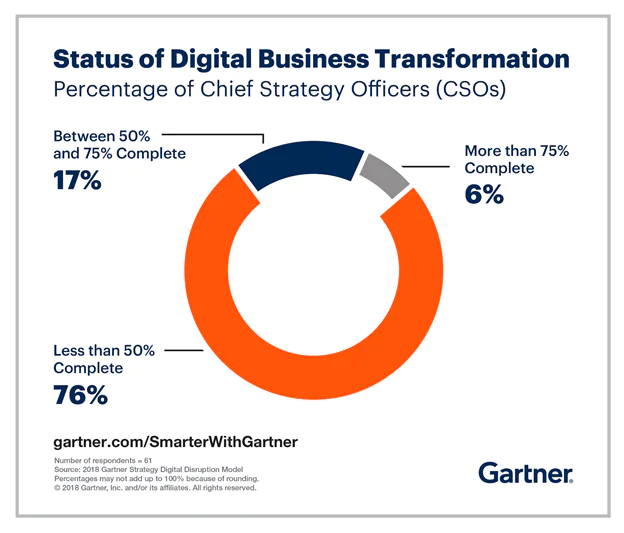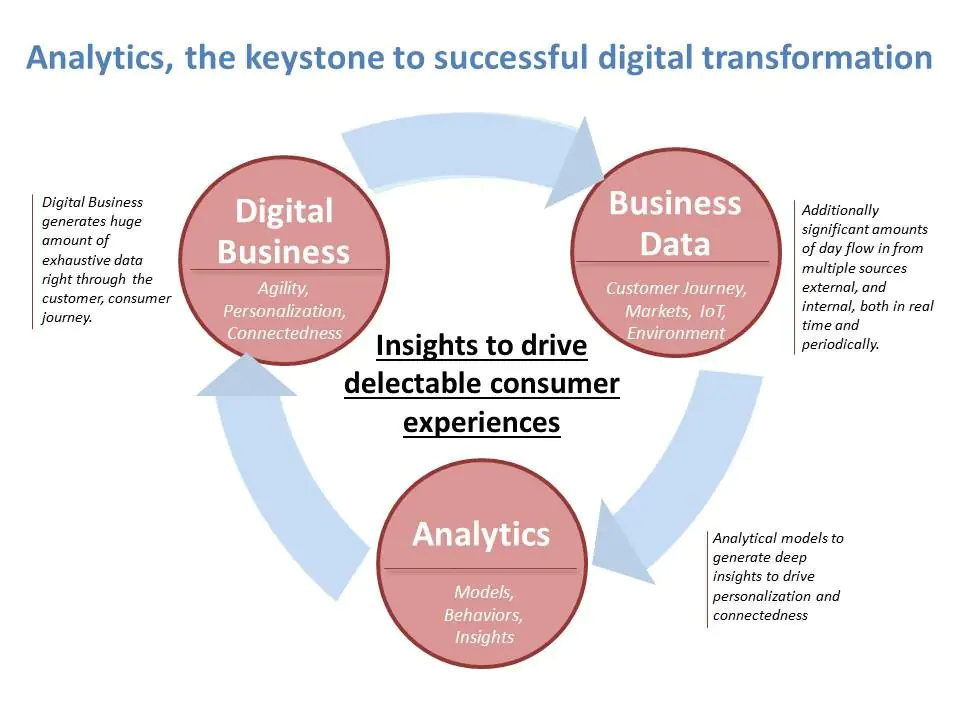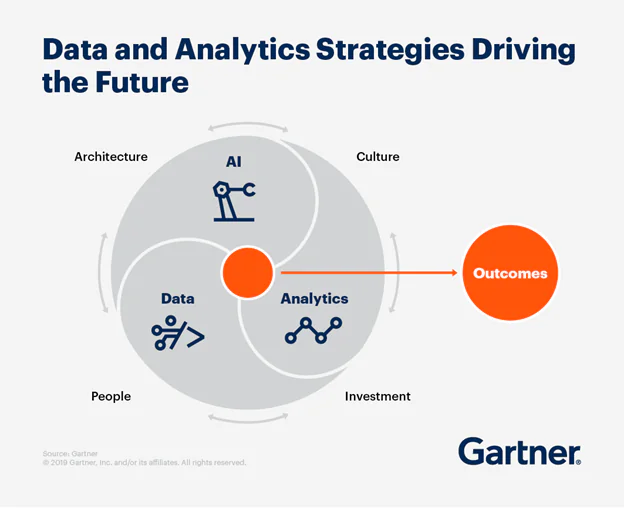Digital transformation is a hot topic in the business world, and for good reasons. There are a myriad of articles out there from companies that have been successful with digital transformation. To really understand what digital transformation can do, we must first know what it is. So, let’s look at the definition of digital transformation.
What is Digital Transformation?
Digital transformation is the process of transforming a company’s fundamental business model to take advantage of new digital technologies. It is not just a matter of digitizing a product or service, but rather a matter of reimagining and reinventing them to deliver them to customers in perfect sync with their ever-changing needs.
Digital transformation is the integration of digital technology into all areas of a business, fundamentally changing the way it operates and delivers value to its customers. It is also a cultural shift that requires organizations to constantly challenge the status quo, experiment, and become comfortable with failures. It can involve reworking products, processes, and strategies within the organization by leveraging digital technologies.
This means that digital transformation requires work in many different areas. These include examining your business, modifying your supply chain, incorporating skills in employees and more. Make sure you do a thorough analysis of your industry before making any digital transformation efforts. This will give you a clear picture of the market and what is going on and help you create an effective strategy.
According to a Gartner Survey, “Digitalization is a priority for most businesses. 87% of senior business leaders say it’s important, and 79% of corporate strategists say it’s reinventing their whole business and creating new revenue streams.”
Source: Gartner
And a recent report by IDC states that the global spending on the digital transformation market is projected to grow to $2.8 trillion by 2025, at a compound annual growth rate (CAGR) of 16.4%.
Digital transformation helps an organization leverage some of the latest technologies and keep pace with emerging customer demands. It enables organizations to better compete in an economic environment that is constantly changing as technology evolves.
8 Key Technologies Involved in Digital Transformation
Technology is making digital transformation inevitable and supporting digitization within an organization. Digital transformation can’t be achieved through just one solution or technology, but there are several key processes that an organization usually needs to tackle the same.
One of the most important aspects of a company’s digital transformation will be to focus on new technologies, such as Artificial Intelligence-powered assistants, that can make communication easier and more efficient between employees, customers, and service providers and streamline the different production processes effectively.
In this sense, it is important to highlight the role of the 8 digital enablers, whose application and operation will allow businesses to embrace Digital Transformation:
- IoT – The Internet of Things (IoT) is a subset of digital transformation that deals with the interconnectedness of physical objects. It is a network of physical objects that are embedded with electronics, software, sensors, and connectivity to enable these objects to collect and exchange data. The Internet of Things is revolutionizing industries right now, and it is predicted that such revolutionary technology will only grow exponentially in the next few years. The IoT allows businesses to be more productive through real-time data, and improve processes through efficiency. According to Omdia, 90% of Enterprises state that IoT was core to their digital transformation plans or being deployed across multiple areas of their organization.
- Data Science – Data science is a relatively new field that has emerged as the result of digital transformation. It’s about using data to solve business problems and create value for companies. Data scientists are well-versed in statistics, computer programming, and other quantitative disciplines. They use these skills to analyze data and turn them into meaningful insights. Technologies such as Big Data, for example, allow predictive, descriptive, and prescriptive analysis of the information provided by massive data, thus facilitating decision-making within companies. The biggest benefit that enterprises get is that they are able to collect a variety of customer data and offer data-based products to customers.
- Blockchain – Blockchain technology is a decentralized and distributed digital ledger that can record transactions between two parties efficiently and in a verifiable and permanent way. It is therefore a disruptive decentralized technology, incorruptible and without the possibility of being manipulated, which guarantees data exchange and transfer activities in a transparent and secure manner, guaranteeing user privacy. According to PWC, 77% of financial institutions are expected to adopt blockchain technology as part of a production system or process.
- Artificial Intelligence/ Machine Learning – Artificial intelligence is gradually gaining traction in our lives. Without a doubt, this is one of the technologies that is having the greatest impact in the business world. AI-powered assistants, including cutting-edge restaurant payroll software, are revolutionizing communication, enhancing employee management, and streamlining operational processes, making them one of the key technologies driving impactful changes in the business world. It allows organizations to take advantage of automatic and continuous learning (Machine Learning), i.e, it simulates human intelligence based on experience, to redesign business processes and innovate. Automation in process chains, facial and voice recognition for access control or automatic payments are just some examples of uses that AI is facilitating.
- Mixed reality – Mixed reality combines virtual and augmented reality to create the immersion of virtual content as if it was in the real world. In other words, it is possible to interact with holograms, transforming our workplace into a unique experience that allows us to integrate people, places, and objects from the physical and digital worlds to create virtual prototypes, perform less invasive surgeries in the medical field or offer assistance services for businesses remotely.
- Cloud Computing – One of the biggest aspects of Digital Transformation is the migration of in-house computing infrastructure to the cloud. The cloud is integral to pursuing a Machine First approach to digital transformation. The cloud’s automated processes make it possible for companies to exploit new ways of doing business. Rather than keeping the up-front costs to maintain your own data centers, an enterprise can leverage cloud computing resources and capitalize on an enormous network of on-demand computing power for data analysis, and other capabilities to reduce the cost of ownership than traditional computing architectures. The cloud is the place where digital natives like Amazon, Uber, Spotify etc. have been able to build disruptive businesses by taking advantage of its flexibility, scalability, affordability, and capabilities in loading quantum data. Amazon Web Services, Microsoft Azure and Google Cloud are some of the most reliable, scalable and inexpensive cloud computing services available.
- Customer Experience (CX) – Digital Transformation should start with the customer experience in mind. There are many channels for consumers to receive info, buy goods or services and of course, read reviews. For the company’s customer experience (CX) and user experience (UX) to be consistent across all of them, a seamless multi-channel experience is not an “option” anymore – it is an absolute necessity. With consumers in control of what they want from brand experiences, businesses absolutely need to understand their target audiences on an individual level. That way, every touchpoint along a customer’s journey can be individually optimized which will help them stay connected with current and potential customers.
- Cloud-enabled Migration and Agility: Organizations need to capitalize on technologies that increase their productivity. They need to be able to adapt and change faster than ever before to stay ahead of the competition. Both Legacy Cloud Migration and CI/CD are great ways to drive IT Transformation. They allow organizations to develop new services faster and more securely. By developing your app and getting quality assurance, code deployment, and testing outsourced to the cloud you will have maximum agility. Migrating to the cloud offers many advantages for CI/CD. It reduces time and cost compared to maintaining physical servers while at the same time speeding up development.
How can Data Drive Digital Transformation?
Data is at the heart of digital transformation because every interaction in the digital world generates data. This data lets you create baselines and benchmarks, which provide a good indicator of progress. This requires careful orchestration of a comprehensive data strategy that will allow your data to be discovered, analyzed, and used to generate actionable insights for desired outcomes. Powerful machine learning and AI can generate models to assist with this process.
Organizations that see digital transformation as a pure technology shift rather than also taking into account how to rethink business processes will end up missing out on the true power of digital transformation.
Source: Linkedin
A digital transformation journey moves an organization from a process-defined world to a data-driven world. Let’s look at why this is powerful and how it changes the value an organization delivers to customers and end-users.
Forrester survey says that, “Firms make fewer than 50% of their decisions based on quantitative information as opposed to gut feeling, experience, or opinion.” The same survey showed that 85% of respondents want to improve their skill in data insights, yet 91% find it challenging to do so.
Although it might seem overwhelming to have so much data, analyzing and aggregating the massive amount of data can bring significant value to your company. Relying on big data analytics can help you provide a personalized customer experience that is unlike any other.
According to Gartner, 90% of corporate strategies will explicitly mention ‘data’ as a critical enterprise asset and analytics as an essential competency.
As data and the ability to associate that data with indicators or problems emerges, an organization can not only become more efficient but also change what it does. If your business is relatively data-driven, the next logical step may be to make sure you understand what data shows you. By examining the world through a ‘data lens’ rather than a ‘process lens’, you are more likely to enjoy its benefits.
Data is key to understanding customers and their preferences. Structured data, like that from CRM systems, helps organizations generate insights about their customers based on their past purchases and historical transactions. Organizations can also collect unstructured customer data from social media and listen to what their customers want through their online posts, comments, and sentiments. This increased understanding enables organizations to optimize their sales channel strategies to fit the needs and preferences of their customers.
Additionally, customer data helps organizations tailor their sales channels for more personalized service and engagement. For example, a customer’s purchase history allows an organization to give that customer some personalized recommendations based on their past actions, thereby maximizing cross-selling and upselling opportunities.
Data Analytics is driving the future of Businesses
Data analytics is an important component of any digital transformation strategy. It is essential for organizations to collect, process, analyze and share data in order to make better decisions. The data analytics process includes collecting data from various sources, processing the data into a form that can be analyzed, and then analyzing the data in order to find patterns or insights that will help you make decisions. Data Analytics helps organizations in making better decisions by providing them with insights into their customers’ needs and wants.
According to Gartner’s View From the Board of Directors Survey, a striking 66% listed digital technology initiatives as their top priority, compared with 29% that identified customer engagement as their next most important area of focus.
Source: Gartner
Today’s digital transformation, brought about by the explosion of data and connected devices, should be seen as a world of opportunity for businesses, rather than a threat. The secret sauce for survival, however, is based on a cultural shift that focuses on the value of data analysis. Companies that consider analytics as a critical part will get the most benefit from their data, now and in the future.
Organizations that invest in data collection and analysis will prevent their demise in the digital age. Innovating and generating new ideas on how to use this knowledge to create new products and improve customer experiences is the next step in the process. Finally, improvisation and exploration of data to find new meaning will give rise to a series of ideas that will feed the cycle of continuous data.
Be Agile To Start With Digital Transformation
Consumer behavior is constantly changing along with work preferences, needs, ways of thinking and purchasing products. Those behaviors first changed from decade to decade or every five years; then year after year, now it is getting faster, so companies must go at the same speed, or they will be left behind.
For an organization to match or improve the speed of change that is happening outside, it is necessary that there be important changes within the organization, from innovation and the way they think, to the deployment of the products and services they offer. Digital transformation enables an organization to speed up the change process, make an Agile approach possible, and learn faster from consumers and competitors. Organizations will know if their operations are running smoothly and if they are behaving as expected. With this knowledge, organizations can draw conclusions from the data and adapt their strategy accordingly.
With the Agile culture, teams are in control and work together instead of working as individuals. They learn to listen to others’ opinions and think out of the box. The synergy this creates leads to a more profound understanding of their role and changes how they see themselves as people. They understand the value that they are generating, they are autonomous, they have more responsibility, self-managed, and decision-making power, in addition, they obtain iterative and incremental results.
When an Agile culture is implemented, too many things change in the organization, so it is necessary to train people so that they learn to work in a different way and begin to change concepts, beliefs, and ways of thinking. Businesses must embrace adaptable differentiation and develop a “digital agility advantage”. That way, they can constantly adjust to the changes in the market and keep up with new technological innovations.
According to Deloitte, 80% of federal IT projects follow Agile methodologies. It’s very common for federal agencies to be slow to adopt new practices or approaches, but Agile has been picking up steam. The federal government annually spends more than $90 billion on IT. There are challenges faced by federal agencies when it comes to developing, implementing, and maintaining their IT investments, but the fact that Agile is been adopted by federal agencies also speaks to its mainstream appeal of it as a process for innovation.
Source: Deloitte
Final Thoughts
Industry 4.0 is here to stay and therefore, it is important that companies accept this reality and understand it as a golden opportunity to face the inevitable process of digital transformation that they must undertake to boost the growth of their business. Deciding which technological enablers to use and how to do it is what will not only allow them to be more competitive in the current market but also what will make a difference within their sector, guaranteeing their success.
We must understand Digital Transformation as a change of paradigm, business model, and business vision. Considering that we live in a digital world, making changes involves implementing technology, however, Digital Transformation goes beyond just that. Those who successfully go through the process of digital transformation will reap the benefits of increased value, competitive advantages, and new business opportunities. Those who do not adjust will quickly be surpassed by their competition and will eventually disappear.
We @ NimbleWork
We are building and launching a range of embedded AI tools and related services to our customers. AI-driven Enterprise Agility for successful Digital Transformation – that is our mantra. Our AI/ ML tools and services will help in Predictive planning, development, testing and operations. Our Nimble suite of products will power the next-generation AI-driven Enterprise Agility platform to accelerate our customers’ Digital Transformation (DX) initiatives. Connect with us to learn more about how we can help your AI/ ML and DX initiatives with our products and consulting services.
If you need any help with your Digital Transformation (DX) initiatives, our specialists are just an email away! Get in touch with us and see how we can help you Digitally transform your enterprise.










